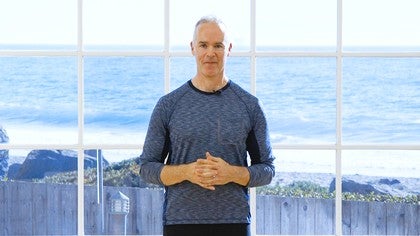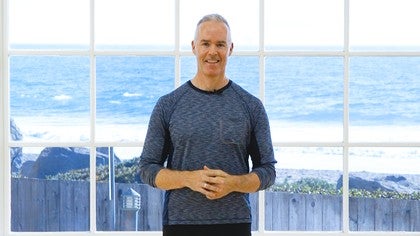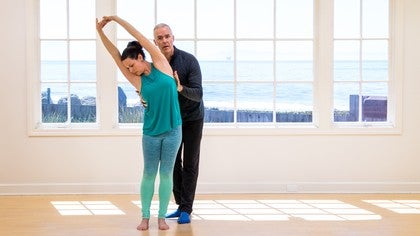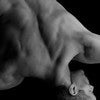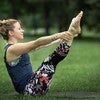Description
About This Video
Transcript
Read Full Transcript
Hi, everybody, I'm Tom McCook. I'm back here at Pilates Anytime. I own a studio called Center of Balance in Mountain View, California, and it's just a great pleasure to be back. So what I want to share is in my teaching what has changed and why. And why it's actually more important to me to teach a little bit differently.
It's really still pilates what I'm teaching for the main part, but I'm teaching more of an understanding of function, and I've just learned some really cool stuff that is changing how people use their body. They're becoming more inspired, and you can give 'em really good tools that they can help themselves. And for that, what's better than that? Pilates is great, but for me, as I know over the years that I've been teaching, my reasons for teaching have changed as my maturity as a teacher and just my personal interest. And where I am now is I'm much more interested in helping people function better, but for that to happen, I need to understand how the body's designed.
And my road for the last 15 years has been to do the Franklin work, which is all about how the body's designed based on evolution. How to use your mind and attention, touch, and apply that to helping people function better. And then I teach it, or I apply it to pilates. And that's just been a great inroad for me to teach around the world and to help people in a very useful way that's fun to teach. So now, here I am, 15 years into that, and I just took this course called Anatomy in Motion with Gary Ward, the creator of Anatomy in Motion, and it's another example of improving function based on walking and the gait cycle.
What Gary has done is he's taken the gait cycle and he's broken it down into what's supposed to happen in each joint from your big toe to your head in three dimensions through seven phases of gait. And that's pretty mind blowing. So through understanding that, you can use an assessment to look at somebody's body and see where maybe there's too much movement or too little. And then apply that to, with simple ways, and I've been combining it with the Franklin work, so I give people an understanding of where things are in their body simply just through self touch, where are the joints, how do I put my attention there? And it's really changing how I teach and it's just been fabulous.
I highly recommend Gary Ward's work. He has a book called What the Foot? His website is www.whatthefoot.co.uk. He also has www.findingcentre, center is C-E-N-T-R-E.co.uk. So you'll find information on his courses.
And then also I have to mention Eric Franklin. The Franklin method has been life changing for me and my teaching. So why does gait matter? We have people come in, we do reformer work, we do work, we do mat work, we do all this stuff, and it definitely positively affects their gait. But what do we do most of the time?
We relate to gravity and we walk. So there's a lot of repetitions of being gravity and walking, and with all the possibilities what can happen in the body, it might be the root of the dysfunctions that we're seeing in the body. And for all of us, most of us, since we were very young, we've been wearing shoes, and that's been inhibiting the rhythm of the feet, which affects every joint up the chain. So if you're gonna go into understanding gait, you've gotta go into understanding the body on a deeper level. And I've found through this study I've been doing for this period of time, and doing it with my own body, it's changed my own body dramatically.
I've been dealing with a foot injury for a few years where I've had a neuroma in my right foot. And in the middle of the course, it went away. And I got to really look at where in my gait cycle was the problem. And it stems back from injuries over the course of our life, my life in particular. And that information was so valuable that I could apply it directly to what I'm doing.
And then the minute I start to learn it in my body, I'm starting to see it in other people's body more clearly. So what do you do to assimilate something new that changes your understanding without losing confidence? So here I am, 30-plus years in. I'm teaching something very different than I was teaching before, but I'm also super excited about it. So for me, the number one thing, if you're going to introduce something to your teaching, you don't throw everything out with the bath water.
You actually first practice it yourself a lot. And for me, I've been practicing this daily for the last several months. Along with my understanding of the body that was already there. And I'm just finding, "Okay, what can I introduce to my students in my classes in a way that they can rock it while we're doing it, they can embody it, and then sense the difference? So part of that is giving them an opportunity to first feel what they're currently doing, before you introduce it all.
And I think as a way of teaching, that's a really good thing to do is give people a few more times in your sessions to just feel their body without doing anything. What is their current pattern? Whether it's their standing pattern, how their back feels on the floor when they lie down to begin your mat class, how their feet feel on the floor. Give them an opportunity just to notice their current patterns. And I'm finding just doing that a little bit more gives you an opportunity to teach a new pattern so they can actually notice the change.
And that for me has been enormous. So how do I introduce a new concept to my students? Number one, practice it yourself until you feel a clear understanding of it from the standpoint that you understand it in your own body, and you feel pretty clear about how you're gonna communicate it verbally. I wouldn't introduce any new concepts about the design or function of the body until then, so that might take, depending on where you're at in your own understanding of the body, might take anywhere from a few sessions for yourself to a few months. So just take your time with that.
You don't need to change what you're currently doing, or that what you're doing is wrong. The way I look at it, there's always degrees of better. And hopefully we're all getting better because we're noticing what we're doing. And then if we learn something that changes your perception, you can feel it's better, that's a good idea to keep going with that. So that's the way that I see it, is you have to actually apply that.
And where does our inspiration come from? It comes from learning really useful information that we can share with others to create a positive change in their life. And this information is much bigger than the pilates work. The pilates is just an application you're going to put to it, where it'll help you be a better teacher if that's one of your goals. Or if you're a student of pilates, it'll help you perform the exercises better and get better results out of them.
So I hope I've conveyed enough on that particular point. The other point that I'm finding more and more is, especially from the work I've been doing with the Franklin method, is to educate your clients on how to use their mind better. So that means, where is their attention when they're doing a particular exercise? So that could be... And if you're gonna give 'em an anatomical cue, make sure that they understand that part of their anatomy.
If they don't, you've cued them in a way that will cause confusion. So if someone says to me, engage your core. I have no idea what that means, and I teach. I might go that means somewhere in here, pull it in and hold it. That would be my first interpretation of that.
Probably not correct. So if you're gonna give people a cue for their abdominal wall, in particular, be specific about it, and maybe give 'em a little bit of understanding. Take one to three minutes to say this is where the muscles attach, this is what they do. Let's just feel that for a moment. Then put it into the exercise.
Otherwise, as a repetitive cue, "Bellybutton to spine, "pull your core in," I don't recommend that. Personally, I don't like to hear that myself, anyway. As an example, "Bellybutton to spine," not a bad cue, but there's a probably more appropriate time when you can give it. If you're giving it when somebody's inhaling, when their abdominal wall needs to push out a little bit because the organs are going down and the diaphragm's going down, might create unnecessary tension. If you do it on the exhale phase when the diaphragm is going up, then the abdomen can actually pull in, then your cue is a little more accurate to what's going on in the body, probably won't create neck tension, and the client will feel the effect, 'cause the cueing is more accurate and more skillful.
So I recommend that you start upgrading your cueing with that regard, where you're combining your understanding as it keeps improving, with imparting that to your client, so in real time, they're learning how to be skillful with themselves based on breath, movement, body understanding, body mechanics. And I think you'll find that the relationship will shift and also the client's attention will get more focused because you're helping all that enhance. I see it this way: as a teacher, you're an external nervous system for your client. You're giving them feedback they can't give themself. And so if you step back and take it that way, remind yourself that they can only take in one or two cues at a time.
If you're bombarding them with cues, who knows what landed? So I've found if I just give 'em a couple of key cues on what I want to see, then I step back and watch, the next thing I need to cue becomes revealed. So I don't have to have pre-canned cues, I need to let the body tell me what it needs. The other thing I've found more and more important when I teach is to include more touch, especially self touch where the client gets to teach themself. That's a great learning opportunity to show them where their joints are, how their muscles are designed, how to let go of tension.
And then you can include that with your cueing where you're touching. You want to get really skillful at cueing. Manual cueing is super important. I have a really long background in body work that I had before I became a pilates teacher, so for me, it became, it was really just intuitive and natural, 'cause I had already done 10,000 plus massages before I became a pilates teacher. So for me, not doing that actually makes you less valuable.
And if you don't have a background of body work training, just set the intention that you're gonna use your hands to cue people in the key areas, where their hip joints are, how their pelvis rolls over their legs, how their shoulders are designed to work, how to keep their spine aligned in every position, how to let go of tension, where breathing happens, how the body's designed to move when you breathe. These are just some examples of what you can do. And just a little bit of self touch goes a long way. Your client will take it in so much faster than a lot of verbal stuff, so the combination of the two needs to be happening for you to create optimal change. Coming back to the gait work that I was talking about, why do I feel it's so important?
Your feet move in three dimensions. We're in shoes. So based on what I learned from Gary, the statistics are 95% of the population is stuck in pronation, only 5% are stuck in supination. There's nothing wrong with pronation. The issue is not rebounding into supination after you pronate every step you take.
And what that does, is if you don't rebound into supination in the push off phase of gait, your posterior chain of your body doesn't turn on as well. So the whole working on our glutes and getting our glutes to fire and having people lie down and do bridges like somehow that's going to translate into gait, doesn't actually work. Your foot is dictating. If your foot is stuck in pronation when it's behind you, the knee habitually wants to bend, and you can't fully load the back of your hip and turn it on. So learning how to use the foot better in relationship to the whole kinetic chain is pretty vital to our posture, our gait, our ability to strengthen our hips, our ability to extend our spine, it's all related.
So with that idea, we have to think a little more deeply about including the feet in every session that we do. So if you currently don't understand them well enough, now you've got a job to do. You've gotta learn a little more about 'em. And I think in general, we don't do enough with the feet. We need to do more of just basically moving them in their three planes so you can feel what they're designed to do, and you have three key weight-bearing points on your foot that should stay on the ground when your heel is down: underneath the ball of your big toe, underneath the ball of your little toe, and the center of your heel.
So think of if you have a triangle on each foot. Inside of that, your foot bones are moving when you bend and straighten the legs. So you don't want to take those points off, especially your front two points. If they come off the floor in the gait cycle, it's gonna distort the whole chain. So how does that relate to what we do in pilates?
We already have our feet on the barre, we do foot work, that's all great. But the other thing that happens as a result of that is there's a rotation in the body and there's an upslip and downslip of the pelvis that we have to start including more. You know, we've all been taught to keep everything square and level, when that's not how your body moves through space. The pelvis rotates, hips hike and drop at different points in the gait cycle. They're designed to do that, 'cause it also encourages different movements of the spine.
It's how the body absorbs force. So great to keep it square, but is it helping how we move through space? We've gotta keep asking that question. And I think, I'm not criticizing pilates per se. What I'm saying is, let's upgrade the understanding of the body so what we're doing in the pilates environment matches, and start to actually keep going in that direction so the client can actually feel the difference and self correct better.
And think of what Gary calls it, he calls it a flow motion model. So when you're moving, everything is moving. So think of stability is really a dynamic exchange of everything moving at the same time. It's not something's fixed. There's times for that, but just I'll leave you with that so you can consider that as a pondering thought.
Everything's moving at the same time. Great to be with you. I hope I see you again soon, and thank you for your time.
The Teacher's Corner: Embrace How You Teach
Comments
Happy New Year!
I totally agree with what you said. The more I approach different kinds of movement and exercise methods, I understand that it is important to integrate all these in Pilates teaching.
When are you going to Hong Kong? Looking forward to learn from you.
- Amanda
You need to be a subscriber to post a comment.
Please Log In or Create an Account to start your free trial.
